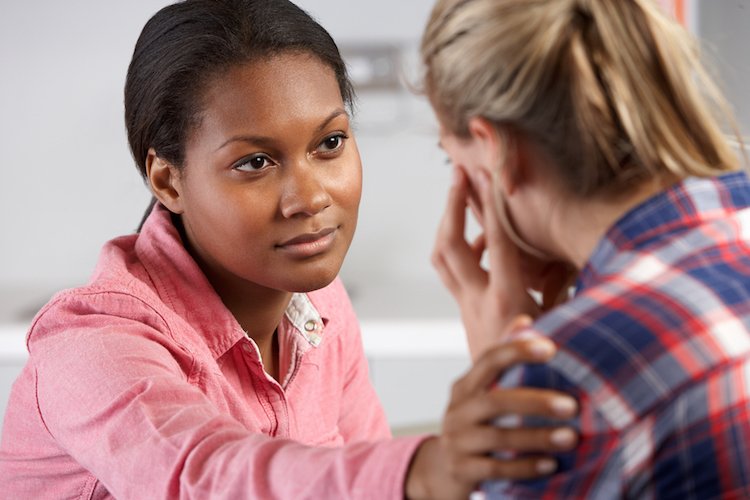A new book explains how we can learn empathy and have better social interactions. By Jill Suttie on behalf of the Greater Good Science Center.
It’s hard to watch someone who is suffering. We may feel their pain or absorb their sorrow; we may worry that we won’t know what to do or say. Those uncomfortable moments might make us turn away from their distress — to preserve our own well-being or to carry on with our lives.
But this is the wrong approach, says psychiatrist and researcher Helen Riess, author of the new book The Empathy Effect. The ability to connect empathically with others — to feel with them, to care about their well-being, and to act with compassion — is critical to our lives, helping us to get along, work more effectively, and thrive as a society.
Most of Riess’s research on empathy has focused on health care. Since doctors are confronted with suffering day in and day out, their situation is fitting for observing how empathy affects well-being. While doctors may think turning off their feelings and creating emotional distance helps them remain objective and provide better care, Riess’s research has shown that doing so makes patients distrustful, disgruntled, and less cooperative. And it makes for lonelier, less effective, and more burned-out physicians. The ability to connect with others is critical fizkes/shutterstock
The ability to connect with others is critical fizkes/shutterstock
What should doctors — and the rest of us — do instead? Practice empathy, says Riess. Not only does being empathic improve health care, she argues, it also improves human interactions in general.
“All parties are equally enriched when we perceive and respond to each other with empathy and compassion,” she writes. “After all, it’s the human bond that adds the music to the words in life.”
What is empathy?
Many confuse empathy (feeling with someone) with sympathy (feeling sorry for someone), and even researchers who study it have muddied the waters with many definitions. But Riess does a good job of untangling that and explaining the many dimensions of empathy.
Empathy, she writes, involves an ability to perceive others’ feelings (and to recognize our own emotions), to imagine why someone might be feeling a certain way, and to have concern for their welfare. Once empathy is activated, compassionate action is the most logical response.
“The ability to connect empathically with others — to feel with them, to care about their well-being, and to act with compassion — is critical to our lives.”
Empathy relies on specific parts of the brain that evolved to enable emotional connection with others and the motivation to care. When we see someone in pain — let’s say, because we witnessed them accidentally cut themselves — pain pathways in our own brains light up, though to a lesser degree. This is the emotional part of empathy — sometimes called emotional resonance — that many doctors ignore or push away, though that works against their compassionate instincts, says Riess.
“[Your] sophisticated neurological system allows you to observe others hurting and gives you just enough of a taste of the pain to consider helping them out,” she writes.
Still, we can’t rely on emotional resonance alone. For one thing, it tends to be stronger for people who are similar to us, and that’s problematic in a doctor’s office… and in life. Luckily, empathy also has a cognitive component — an understanding that our feelings may not be the same as someone else’s. Separating our pain from theirs allows us to soothe any discomfort we feel, while staying curious about what they are going through.
“We must understand the situation from the other person’s physical, psychological, social, and spiritual perspectives,” she says.
The third aspect of empathy is concern — “the inner motivation that moves people to respond and express the urge to care about another person’s welfare.” Unfortunately, that concern varies a lot from person to person and is influenced by different environmental factors, such as how much the person in need resembles you (and your “tribe”), whether you encounter suffering in one person or the suffering of multitudes, whether you think someone deserves to suffer because of their bad behavior, and your social status (the more powerful or rich you are, the less likely you will be to notice suffering and care to intervene).
This suggests that while empathy is a built-in biological response to suffering, we still need to work at it, if we want to use it in more trying situations.
Empathy can be taught
We may find it hard to empathize with some people. But that doesn’t mean we can’t strengthen our empathy muscles, according to Riess. She suggests becoming more adept at perceiving others’ emotions, learning self-regulation techniques to help us not get overwhelmed by excessive emotional resonance, and finding ways to encourage perspective taking.
Empathy is a built-in biological response to suffering
To that end, she has developed a program called EMPATHICS that has been taught to physicians and successfully improves their ability to read emotions and their level of burnout, as well as patient satisfaction. This is good news, as doctor/patient relationships seem to make a significant contribution to patient health.
Riess uses the acronym EMPATHY to outline the steps of her program:
E: Eye contact. An appropriate level of eye contact makes people feel seen and improves effective communication. Riess recommends focusing on someone’s eyes at least long enough to gauge eye color, and making sure you're face to face when communicating.
M: Muscles in facial expressions. As humans, we often automatically mimic other people’s expressions without even realizing it. By being able to identify another’s feelings — often by distinctive facial muscle patterns — and mirroring them, we can help communicate empathy.
P: Posture. Sitting in a slumped position can indicate a lack of interest, dejection, or sadness; sitting upright signals respect and confidence. By understanding what postures communicate, we can take a more open posture — face forward, legs and arms uncrossed, leaning toward someone — to encourage more open communication and trust.
A: Affect (or emotions). Learning to identify what another is feeling and naming it can help us better understand their behavior or the message behind their words.
T: Tone. “Because tone of voice conveys over 38 per cent of the nonverbal emotional content of what a person communicates, it is a vital key to empathy,” writes Riess. She suggests matching the volume and tone of the person you are talking to and, generally, using a soothing tone to make someone feel heard. However, when a person is communicating outrage, moderating your tone — rather than matching theirs — is more appropriate.
H: Hearing. Too often, we don’t truly listen to one another, possibly because of preconceptions or simply being too distracted and stressed. Empathic listening means asking questions that help people express what’s really going on and listening without judgement.
Y: Your response. Riess is not talking about what you’ll say next, but how you resonate with the person you are talking to. Whether or not we’re aware of it, we tend to synch up emotionally with people, and how well we do it plays a role in how much we understand and like them.
Empathy beyond health care settings
While Riess has mostly focused on doctor/patient relationships, her book is a plea to look beyond health care and imagine a world where empathy is infused into everyday life.
Even young children can read others’ emotions and have a propensity to want to help people in distress, Riess points out. We could help them to build on those skills through role modeling and giving them opportunities to flex their empathy muscles. How well parents understand their children’s emotions, try to take their perspective, and affirm their worth is tied to how they do later in life. Eye contact improves effective empathetic communication
Eye contact improves effective empathetic communication
“When a child is not mirrored, he may give up trying to achieve his goals, or if he becomes a high-achiever, his accomplishments may give him little pleasure,” she writes.
Of course, as children grow, other relationships become important, too. School teachers can increase children’s sense of self-worth by treating them with respect and warmth, avoiding harsh disciplinary tactics, and engaging them in learning, says Riess. They can also directly teach empathy through literature, simulations, and other techniques.
“We may find it hard to empathize with some people. But that doesn’t mean we can’t strengthen our empathy muscles.”
Riess describes other instances where empathy is crucial — for example, when we encounter people who are different from us, when we ourselves have made a mistake and need self-empathy, in our workplaces, and even within government. And she examines the potential downsides of empathy, too — like when perspective taking is used to get inside people’s heads and manipulate them rather than to show caring.
Still, the importance of empathy in everyday life cannot be oversold. By understanding how it works and can be augmented in ourselves and our children, we have one of the key tools to cultural transformation, Riess believes.
She writes, “We have hope to help shape a more civil society, respectful discourse, understanding of others, and a humane world.” ●
Main image: Pressmaster/shutterstock
Written by Greater Good Science Center
 This article originally appeared on Greater Good, the online magazine of the Greater Good Science Center at UC Berkeley. happiness.com is honoured to republish it with the kind permission of the Greater Good Science Center. greatergood.berkeley.edu
This article originally appeared on Greater Good, the online magazine of the Greater Good Science Center at UC Berkeley. happiness.com is honoured to republish it with the kind permission of the Greater Good Science Center. greatergood.berkeley.edu
Join the conversation
You are posting as a guest. If you have an account, sign in now to post with your account.